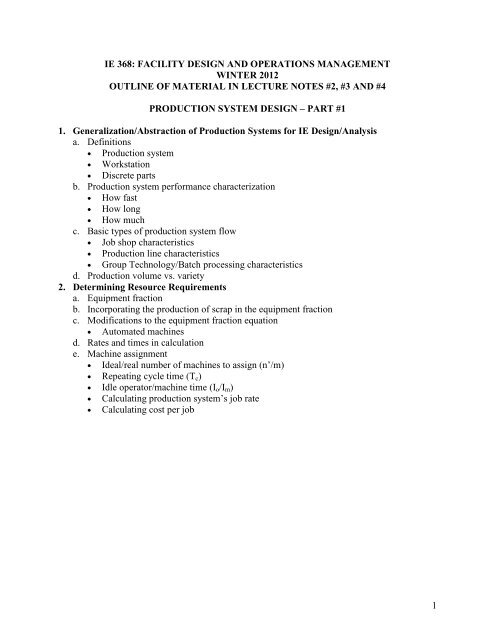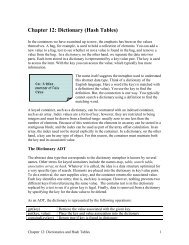Midterm outline - Classes
Midterm outline - Classes
Midterm outline - Classes
You also want an ePaper? Increase the reach of your titles
YUMPU automatically turns print PDFs into web optimized ePapers that Google loves.
IE 368: FACILITY DESIGN AND OPERATIONS MANAGEMENT<br />
WINTER 2012<br />
OUTLINE OF MATERIAL IN LECTURE NOTES #2, #3 AND #4<br />
PRODUCTION SYSTEM DESIGN – PART #1<br />
1. Generalization/Abstraction of Production Systems for IE Design/Analysis<br />
a. Definitions<br />
• Production system<br />
• Workstation<br />
• Discrete parts<br />
b. Production system performance characterization<br />
• How fast<br />
• How long<br />
• How much<br />
c. Basic types of production system flow<br />
• Job shop characteristics<br />
• Production line characteristics<br />
• Group Technology/Batch processing characteristics<br />
d. Production volume vs. variety<br />
2. Determining Resource Requirements<br />
a. Equipment fraction<br />
b. Incorporating the production of scrap in the equipment fraction<br />
c. Modifications to the equipment fraction equation<br />
• Automated machines<br />
d. Rates and times in calculation<br />
e. Machine assignment<br />
• Ideal/real number of machines to assign (n’/m)<br />
• Repeating cycle time (T c )<br />
• Idle operator/machine time (I o /I m )<br />
• Calculating production system’s job rate<br />
• Calculating cost per job<br />
1
PRODUCTION SYSTEM DESIGN – PART #2<br />
1. Performance Evaluation<br />
a. Throughput<br />
b. System responsiveness (TIQ, TIS)<br />
c. WIP levels (WIP Q , WIP)<br />
2. Queuing theory<br />
a. Probability and statistics concepts<br />
• Random variable<br />
• Expected value<br />
• Variance<br />
• Coefficient of variation<br />
3. Utilization<br />
a. Needed to evaluate WS performance<br />
b. Need effective process time (t e ) and job interarrival time (t a )<br />
• Both given or calculated from data<br />
c. Classification of CVs<br />
4. Queuing models for performance evaluation<br />
a. WS m = 1 (simplest case)<br />
• Concept of throughput based on WS’s utilization (is u ≤ or equal to 1?)<br />
− See formulation for TIQ & TIS<br />
• Little’s law Throughput (TP) times either WIP Q or WIP<br />
• Examination of queuing model (relationships amongst parameters in queuing model)<br />
PRODUCTION SYSTEM DESIGN – PART #3<br />
1. Queuing models for performance evaluation (continued)<br />
a. Generalizations of queuing model<br />
• WS m = n (multiple parallel machines)<br />
− See formulation<br />
b. Generalizations of utilization formula<br />
• WS m = n (non-identical machines), 1 job type<br />
• WS m = n (identical machines), 2 job types<br />
• WS m = n (non-identical machines), n job types<br />
c. Multiple linked workstations<br />
• Coefficient of variation for the interdeparture times (CV d )<br />
• Formula to calculate CV d is different if:<br />
− WS m = 1<br />
− WS m = n<br />
d. Automated systems<br />
• Need to estimate t e and CV e<br />
• Comparison of t e and CV e vs. changes in MTTR and MTBF<br />
e. Batched arrivals and departures<br />
• Estimate t a and CV a<br />
• Selection of the queuing model to use depends on same conditions as before.<br />
2

















